递归神经网络英文课件-Chapter 9 Optimization of training
- 格式:pdf
- 大小:2.50 MB
- 文档页数:50

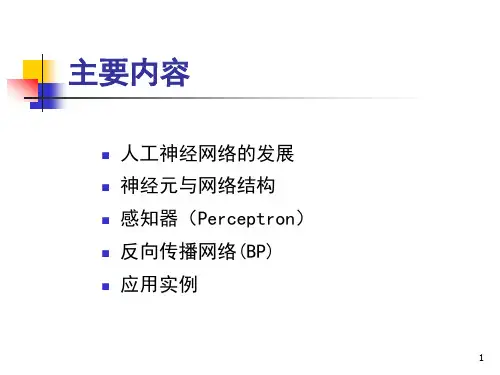

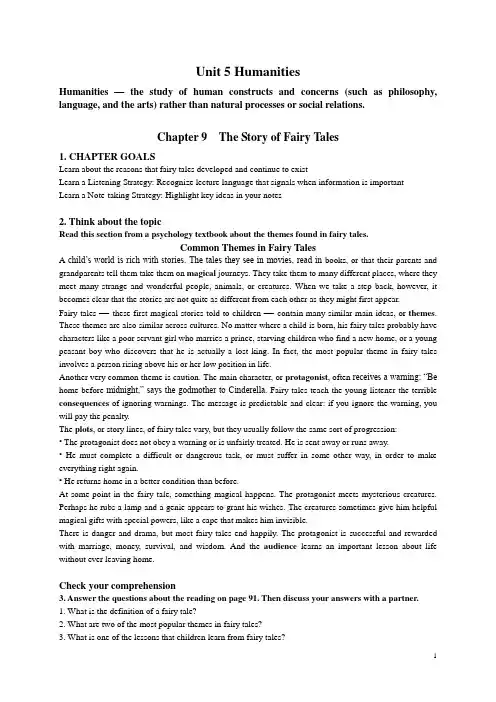
Unit 5 HumanitiesHumanities —the study of human constructs and concerns (such as philosophy, language, and the arts) rather than natural processes or social relations.Chapter 9 The Story of Fairy Tales1. CHAPTER GOALSLearn about the reasons that fairy tales developed and continue to existLearn a Listening Strategy: Recognize lecture language that signals when information is importantLearn a Note-taking Strategy: Highlight key ideas in your notes2. Think about the topicRead this section from a psychology textbook about the themes found in fairy tales.Common Themes in Fairy TalesA child’s world is rich with stories. The tales they see in movies, read in books, or that their parents and grandparents tell them take them on magical journeys. They take them to many different places, where they meet many strange and wonderful people, animals, or creatures. When we take a step back, however, it becomes clear that the stories are not quite as different from each other as they might first appear.Fairy tales —these first magical stories told to children —contain many similar main ideas, or themes. These themes are also similar across cultures. No matter where a child is born, his fairy tales probably have characters like a poor servant girl who marries a prince, starving children who find a new home, or a young peasant boy who discovers that he is actually a lost king. In fact, the most popular theme in fairy tales involves a person rising above his or her low position in life.Another very common theme is caution. The main character, or protagonist, often receives a warning: “Be home before midnight,” says the godmother to Cinderella. Fairy tales teach the young listener the terrible consequences of ignoring warnings. The message is predictable and clear: if you ignore the warning, you will pay the penalty.The plots, or story lines, of fairy tales vary, but they usually follow the same sort of progression:• The protagonist does not obey a warning or is unfairly treated. He is sent away or runs away.•He must complete a difficult or dangerous task, or must suffer in some other way, in order to make everything right again.• He returns home in a better condition than before.At some point in the fairy tale, something magical happens. The protagonist meets mysterious creatures. Perhaps he rubs a lamp and a genie appears to grant his wishes. The creatures sometimes give him helpful magical gifts with special powers, like a cape that makes him invisible.There is danger and drama, but most fairy tales end happily. The protagonist is successful and rewarded with marriage, money, survival, and wisdom. And the audience learns an important lesson about life without ever leaving home.Check your comprehension3. Answer the questions about the reading on page 91. Then discuss your answers with a partner.1. What is the definition of a fairy tale?2. What are two of the most popular themes in fairy tales?3. What is one of the lessons that children learn from fairy tales?Expand your vocabulary4. Match the words from the reading with their definitions. These words will also be in the lecture. Look back at the reading on page 91 to checkyour answers.1. magical a. the people listening to a story2. creature b. one of the players in a story3. theme c. a living thing in a fantasy story that is not a person4. character d. strange and removed from everyday life5. protagonist e. the main subject or idea in a story6. consequence f. the events that form the main action of a story7. plot g. something that happens as result of an action8. audience h. the main player in a story5. Circle the phrase that best completes the meaning of the underlined idiom.We know that fairy tales from different cultures have different characters and settings, but when we take a step back we understand things _________.a. in a new wayb. in a better wayc. in the wrong wayDiscuss the reading6. Discuss these questions in a small group. Share your answers with the class.1. What are some of the lessons that you remember learning from fairy tales?2. What are some of the magical objects and creatures that you remember from fairy tales? As a child, which of these things did you wish could have or meet?7. Study the meaning of these general academic words. Then fill in the blanks below with the correct words in the correct form. These words will be used in the lecture.purpose: the reason for doing or making somethingassume: to think that something is true although there is no proofPeople _________ many things about fairy tales without really thinking about them. Let’s look at the ________ of fairy tales from an educational point of view.8. Read this transcript from a lecture on fairy tales. Take notes and highlight key points and important information.I’d like to focus on one of the common themes that we see in fairy tales, ... one idea that runs throughout every story —we must be cautious… Let me repeat that idea,… we must live cautiously. In these tales, peace and happiness can only exist if warnings are obeyed. This idea is key to fairy tales.Let’s look at a few examples. Cinderella may have a magical dress, but she must be back when the clock strikes twelve. The king may invite fairies to the party for the new princess, but he must invite ALL the fairies or terrible results will follow.This idea that we see in every story is very important,. . . the idea that all happiness depends on one action. All will be lost if one bad thing happens.。
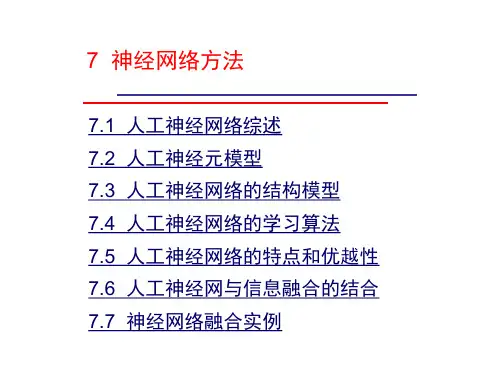

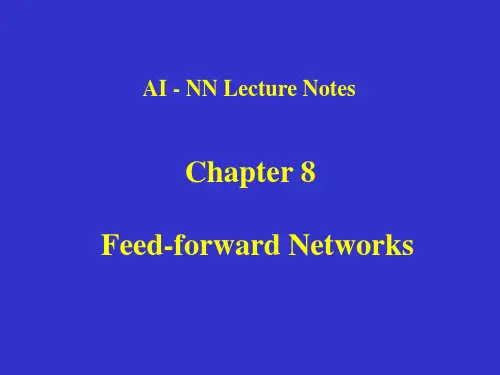


卷积神经网络机器学习相关外文翻译中英文2020英文Prediction of composite microstructure stress-strain curves usingconvolutional neural networksCharles Yang,Youngsoo Kim,Seunghwa Ryu,Grace GuAbstractStress-strain curves are an important representation of a material's mechanical properties, from which important properties such as elastic modulus, strength, and toughness, are defined. However, generating stress-strain curves from numerical methods such as finite element method (FEM) is computationally intensive, especially when considering the entire failure path for a material. As a result, it is difficult to perform high throughput computational design of materials with large design spaces, especially when considering mechanical responses beyond the elastic limit. In this work, a combination of principal component analysis (PCA) and convolutional neural networks (CNN) are used to predict the entire stress-strain behavior of binary composites evaluated over the entire failure path, motivated by the significantly faster inference speed of empirical models. We show that PCA transforms the stress-strain curves into an effective latent space by visualizing the eigenbasis of PCA. Despite having a dataset of only 10-27% of possible microstructure configurations, the mean absolute error of the prediction is <10% of therange of values in the dataset, when measuring model performance based on derived material descriptors, such as modulus, strength, and toughness. Our study demonstrates the potential to use machine learning to accelerate material design, characterization, and optimization.Keywords:Machine learning,Convolutional neural networks,Mechanical properties,Microstructure,Computational mechanics IntroductionUnderstanding the relationship between structure and property for materials is a seminal problem in material science, with significant applications for designing next-generation materials. A primary motivating example is designing composite microstructures for load-bearing applications, as composites offer advantageously high specific strength and specific toughness. Recent advancements in additive manufacturing have facilitated the fabrication of complex composite structures, and as a result, a variety of complex designs have been fabricated and tested via 3D-printing methods. While more advanced manufacturing techniques are opening up unprecedented opportunities for advanced materials and novel functionalities, identifying microstructures with desirable properties is a difficult optimization problem.One method of identifying optimal composite designs is by constructing analytical theories. For conventional particulate/fiber-reinforced composites, a variety of homogenizationtheories have been developed to predict the mechanical properties of composites as a function of volume fraction, aspect ratio, and orientation distribution of reinforcements. Because many natural composites, synthesized via self-assembly processes, have relatively periodic and regular structures, their mechanical properties can be predicted if the load transfer mechanism of a representative unit cell and the role of the self-similar hierarchical structure are understood. However, the applicability of analytical theories is limited in quantitatively predicting composite properties beyond the elastic limit in the presence of defects, because such theories rely on the concept of representative volume element (RVE), a statistical representation of material properties, whereas the strength and failure is determined by the weakest defect in the entire sample domain. Numerical modeling based on finite element methods (FEM) can complement analytical methods for predicting inelastic properties such as strength and toughness modulus (referred to as toughness, hereafter) which can only be obtained from full stress-strain curves.However, numerical schemes capable of modeling the initiation and propagation of the curvilinear cracks, such as the crack phase field model, are computationally expensive and time-consuming because a very fine mesh is required to accommodate highly concentrated stress field near crack tip and the rapid variation of damage parameter near diffusive cracksurface. Meanwhile, analytical models require significant human effort and domain expertise and fail to generalize to similar domain problems. In order to identify high-performing composites in the midst of large design spaces within realistic time-frames, we need models that can rapidly describe the mechanical properties of complex systems and be generalized easily to analogous systems. Machine learning offers the benefit of extremely fast inference times and requires only training data to learn relationships between inputs and outputs e.g., composite microstructures and their mechanical properties. Machine learning has already been applied to speed up the optimization of several different physical systems, including graphene kirigami cuts, fine-tuning spin qubit parameters, and probe microscopy tuning. Such models do not require significant human intervention or knowledge, learn relationships efficiently relative to the input design space, and can be generalized to different systems.In this paper, we utilize a combination of principal component analysis (PCA) and convolutional neural networks (CNN) to predict the entire stress-strain curve of composite failures beyond the elastic limit. Stress-strain curves are chosen as the model's target because they are difficult to predict given their high dimensionality. In addition, stress-strain curves are used to derive important material descriptors such as modulus, strength, and toughness. In this sense, predicting stress-straincurves is a more general description of composites properties than any combination of scaler material descriptors. A dataset of 100,000 different composite microstructures and their corresponding stress-strain curves are used to train and evaluate model performance. Due to the high dimensionality of the stress-strain dataset, several dimensionality reduction methods are used, including PCA, featuring a blend of domain understanding and traditional machine learning, to simplify the problem without loss of generality for the model.We will first describe our modeling methodology and the parameters of our finite-element method (FEM) used to generate data. Visualizations of the learned PCA latent space are then presented, along with model performance results.CNN implementation and trainingA convolutional neural network was trained to predict this lower dimensional representation of the stress vector. The input to the CNN was a binary matrix representing the composite design, with 0's corresponding to soft blocks and 1's corresponding to stiff blocks. PCA was implemented with the open-source Python package scikit-learn, using the default hyperparameters. CNN was implemented using Keras with a TensorFlow backend. The batch size for all experiments was set to 16 and the number of epochs to 30; the Adam optimizer was used to update the CNN weights during backpropagation.A train/test split ratio of 95:5 is used –we justify using a smaller ratio than the standard 80:20 because of a relatively large dataset. With a ratio of 95:5 and a dataset with 100,000 instances, the test set size still has enough data points, roughly several thousands, for its results to generalize. Each column of the target PCA-representation was normalized to have a mean of 0 and a standard deviation of 1 to prevent instable training.Finite element method data generationFEM was used to generate training data for the CNN model. Although initially obtained training data is compute-intensive, it takes much less time to train the CNN model and even less time to make high-throughput inferences over thousands of new, randomly generated composites. The crack phase field solver was based on the hybrid formulation for the quasi-static fracture of elastic solids and implemented in the commercial FEM software ABAQUS with a user-element subroutine (UEL).Visualizing PCAIn order to better understand the role PCA plays in effectively capturing the information contained in stress-strain curves, the principal component representation of stress-strain curves is plotted in 3 dimensions. Specifically, we take the first three principal components, which have a cumulative explained variance ~85%, and plot stress-strain curves in that basis and provide several different angles from which toview the 3D plot. Each point represents a stress-strain curve in the PCA latent space and is colored based on the associated modulus value. it seems that the PCA is able to spread out the curves in the latent space based on modulus values, which suggests that this is a useful latent space for CNN to make predictions in.CNN model design and performanceOur CNN was a fully convolutional neural network i.e. the only dense layer was the output layer. All convolution layers used 16 filters with a stride of 1, with a LeakyReLU activation followed by BatchNormalization. The first 3 Conv blocks did not have 2D MaxPooling, followed by 9 conv blocks which did have a 2D MaxPooling layer, placed after the BatchNormalization layer. A GlobalAveragePooling was used to reduce the dimensionality of the output tensor from the sequential convolution blocks and the final output layer was a Dense layer with 15 nodes, where each node corresponded to a principal component. In total, our model had 26,319 trainable weights.Our architecture was motivated by the recent development and convergence onto fully-convolutional architectures for traditional computer vision applications, where convolutions are empirically observed to be more efficient and stable for learning as opposed to dense layers. In addition, in our previous work, we had shown that CNN's werea capable architecture for learning to predict mechanical properties of 2D composites [30]. The convolution operation is an intuitively good fit for predicting crack propagation because it is a local operation, allowing it to implicitly featurize and learn the local spatial effects of crack propagation.After applying PCA transformation to reduce the dimensionality of the target variable, CNN is used to predict the PCA representation of the stress-strain curve of a given binary composite design. After training the CNN on a training set, its ability to generalize to composite designs it has not seen is evaluated by comparing its predictions on an unseen test set. However, a natural question that emerges is how to evaluate a model's performance at predicting stress-strain curves in a real-world engineering context. While simple scaler metrics such as mean squared error (MSE) and mean absolute error (MAE) generalize easily to vector targets, it is not clear how to interpret these aggregate summaries of performance. It is difficult to use such metrics to ask questions such as “Is this model good enough to use in the real world” and “On average, how poorly will a given prediction be incorrect relative to so me given specification”. Although being able to predict stress-strain curves is an important application of FEM and a highly desirable property for any machine learning model to learn, it does not easily lend itself to interpretation. Specifically, there is no simple quantitative way to define whether twostress-strain curves are “close” or “similar” with real-world units.Given that stress-strain curves are oftentimes intermediary representations of a composite property that are used to derive more meaningful descriptors such as modulus, strength, and toughness, we decided to evaluate the model in an analogous fashion. The CNN prediction in the PCA latent space representation is transformed back to a stress-strain curve using PCA, and used to derive the predicted modulus, strength, and toughness of the composite. The predicted material descriptors are then compared with the actual material descriptors. In this way, MSE and MAE now have clearly interpretable units and meanings. The average performance of the model with respect to the error between the actual and predicted material descriptor values derived from stress-strain curves are presented in Table. The MAE for material descriptors provides an easily interpretable metric of model performance and can easily be used in any design specification to provide confidence estimates of a model prediction. When comparing the mean absolute error (MAE) to the range of values taken on by the distribution of material descriptors, we can see that the MAE is relatively small compared to the range. The MAE compared to the range is <10% for all material descriptors. Relatively tight confidence intervals on the error indicate that this model architecture is stable, the model performance is not heavily dependent on initialization, and that our results are robust to differenttrain-test splits of the data.Future workFuture work includes combining empirical models with optimization algorithms, such as gradient-based methods, to identify composite designs that yield complementary mechanical properties. The ability of a trained empirical model to make high-throughput predictions over designs it has never seen before allows for large parameter space optimization that would be computationally infeasible for FEM. In addition, we plan to explore different visualizations of empirical models in an effort to “open up the black-box” of such models. Applying machine learning to finite-element methods is a rapidly growing field with the potential to discover novel next-generation materials tailored for a variety of applications. We also note that the proposed method can be readily applied to predict other physical properties represented in a similar vectorized format, such as electron/phonon density of states, and sound/light absorption spectrum.ConclusionIn conclusion, we applied PCA and CNN to rapidly and accurately predict the stress-strain curves of composites beyond the elastic limit. In doing so, several novel methodological approaches were developed, including using the derived material descriptors from the stress-strain curves as interpretable metrics for model performance and dimensionalityreduction techniques to stress-strain curves. This method has the potential to enable composite design with respect to mechanical response beyond the elastic limit, which was previously computationally infeasible, and can generalize easily to related problems outside of microstructural design for enhancing mechanical properties.中文基于卷积神经网络的复合材料微结构应力-应变曲线预测查尔斯,吉姆,瑞恩,格瑞斯摘要应力-应变曲线是材料机械性能的重要代表,从中可以定义重要的性能,例如弹性模量,强度和韧性。
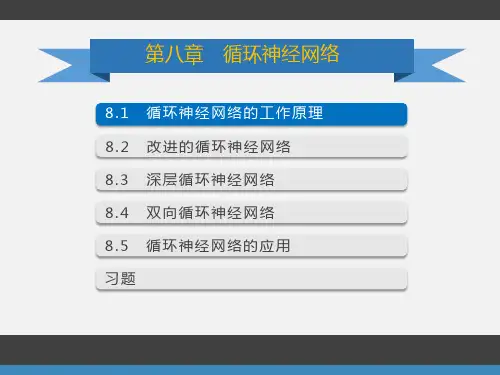
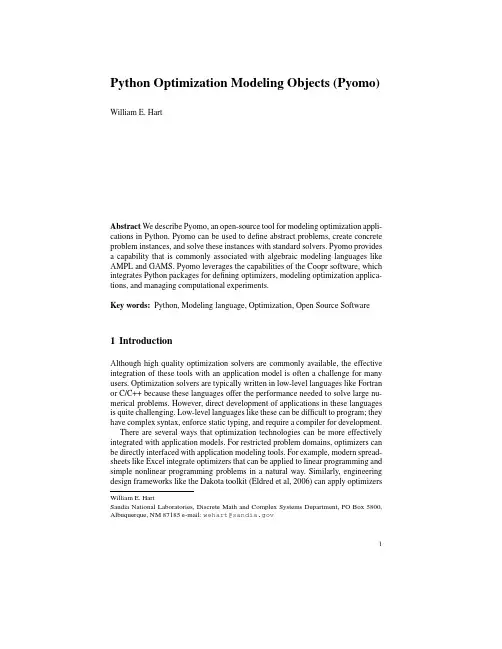
Python Optimization Modeling Objects(Pyomo) William E.HartAbstract We describe Pyomo,an open-source tool for modeling optimization appli-cations in Python.Pyomo can be used to define abstract problems,create concrete problem instances,and solve these instances with standard solvers.Pyomo provides a capability that is commonly associated with algebraic modeling languages like AMPL and GAMS.Pyomo leverages the capabilities of the Coopr software,which integrates Python packages for defining optimizers,modeling optimization applica-tions,and managing computational experiments.Key words:Python,Modeling language,Optimization,Open Source Software1IntroductionAlthough high quality optimization solvers are commonly available,the effective integration of these tools with an application model is often a challenge for many users.Optimization solvers are typically written in low-level languages like Fortran or C/C++because these languages offer the performance needed to solve large nu-merical problems.However,direct development of applications in these languages is quite challenging.Low-level languages like these can be difficult to program;they have complex syntax,enforce static typing,and require a compiler for development.There are several ways that optimization technologies can be more effectively integrated with application models.For restricted problem domains,optimizers can be directly interfaced with application modeling tools.For example,modern spread-sheets like Excel integrate optimizers that can be applied to linear programming and simple nonlinear programming problems in a natural way.Similarly,engineering design frameworks like the Dakota toolkit(Eldred et al,2006)can apply optimizers William E.HartSandia National Laboratories,Discrete Math and Complex Systems Department,PO Box5800, Albuquerque,NM87185e-mail:wehart@12William E.Hart to nonlinear programming problems by executing separate application codes via a system call interface that use standardizedfile I/O.Algebraic Modeling Languages(AMLs)are alternative approach that allows applications to be interfaced with optimizers that can exploit problem structure. AMLs are high-level programming languages for describing and solving mathemat-ical problems,particularly optimization-related problems(Kallrath,2004).AMLs like AIMMS(AIMMS,2008),AMPL(AMPL,2008;Fourer et al,2003)and GAMS(GAMS,2008)have programming languages with an intuitive mathemati-cal syntax that supports concepts like sparse sets,indices,and algebraic expressions. AMLs provide a mechanism for defining variables and generating constraints with a concise mathematical representation,which is essential for large-scale,real-world problems that involve thousands of constraints and variables.A related strategy is to use a standard programming language in conjunction with a software library that uses object-oriented design to support similar math-ematical concepts.Although these modeling libraries sacrifice some of the intu-itive mathematical syntax of an AML,they allow the user to leverage the greater flexibility of standard programming languages.For example,modeling tools like FlopC++(FLOPC++,2008),OPL(OPL,2008)and OptimJ(OptimJ,2008)enable the solution of large,complex problems with application models defined within a standard programming language.The Python Optimization Modeling Objects(Pyomo)package described in this paper represents a fourth strategy,where a high level programming language is used to formulate a problem that can be solved by optimizers written in low-level lan-guages.This two-language approach leverages theflexibility of the high-level lan-guage for formulating optimization problems and the efficiency of the low-level lan-guage for numerical computations.This approach is increasingly common in scien-tific computing tools,and the Matlab TOMLAB Optimization Environment(TOM-LAB,2008)is probably the most mature optimization software using this approach.Pyomo supports the definition and solution of optimization applications using the Python scripting language.Python is a powerful dynamic programming language that has a very clear,readable syntax and intuitive object orientation.Pyomo was strongly influenced by the design of AMPL.It includes Python classes that can concisely represent mixed-integer linear programming(MILP)models.Pyomo is interated into Coopr,a COmmon Optimization Python Repository.The Coopr Opt package supports the execution of models developed with Pyomo using standard MILP solvers.Section2describes the motivation and design philosophy behind Pyomo,includ-ing why Python was chosen for the design of Pyomo.Section3describes Pyomo and contrasts Pyomo with AMPL.Section4reviews other Python optimization pack-ages that have been developed,and discusses the high-level design decisions that distinguish Coopr.Section5describes the Coopr Opt package and contrasts its ca-pabilities with other Python optimization tools.Finally,Section6describes future Coopr developments that are planned.Python Optimization Modeling Objects(Pyomo)3 2Pyomo Motivation and Design PhilosophyThe design of Pyomo is motivated by a variety of factors that have impacted appli-cations at Sandia National Laboratories.Sandia’s discrete mathematics group has successfully used AMPL to model and solve large-scale integer programs for many years.This application experience has highlighted the value of AMLs for real-world applications,which are now an integral part of operations research solutions at San-dia.Pyomo was developed to provide an alternative platform for developing math programming models that facilitates the application and deployment of optimiza-tion capabilities.Consequently,Pyomo is not intended to perform modeling better than existing tools.Instead,it supports a different modeling approach for which the software is designed forflexibility,extensibility,portability,and maintainability. 2.1Design Goals and Requirements2.1.1Open SourceA key goal of Pyomo is to provide an open-source math programming modeling capability.Although open-source optimization solvers are widely available in pack-ages like COIN-OR,surprisingly few open-source tools have been developed to model optimization applications.An open-source capability for Pyomo is motivated by several factors:•Transparency and Reliability:When managed well,open-source projects facil-itate transparency in the software design and implementation.Since any devel-oper can study and modify the software,bugs and performance limitations can be identified and resolved by a wide range of developers with diverse software experience.Consequently,there is growing evidence that managing software as open-source can improve its reliability.•Customizable Capability:A key limitation of commercial modeling tools is the ability to customize the modeling or optimization process.An open-source project allows a diverse range of developers to prototype new capabilities.These extensions can customize the software for specific applications,and they can motivate capabilites that are integrated into future software releases.•Flexible Licensing:A variety of significant operations research applications at Sandia National Laboratories have required the use of a modeling tool with a non-commercial license.Open-source license facilitate the free distribution of Pyomo within other open-source projects.Of course,the use of an open-source model is not a panacea.Ensuring high reliabil-ity of the software requires careful software management and a commited developer community.However,flexible licensing appears to be a distinct feature of open-4William E.Hart source software.The Coopr software,which contains Pyomo,is licensed under the BSD.2.1.2Flexible Modeling LanguageAnother goal of Pyomo is to directly use a modern programming language to sup-port the definition of math programming models.In this manner,Pyomo is similar to tools like FlopC++and OptimJ,which support modeling in C++and Java respec-tively.The use of an existing programming language has several advantages:•Extensibility and Robustness:A well-used modern programming language pro-vides a robust foundation for developing and applying models,because the lan-guage has been well-tested in a wide variety of contexts.Further,extensions typi-cally do not require changes to the language but instead involve additional classes and modeling routines that can be used in the modeling process.Thus,support of the modeling language is not a long-term factor when managing the software.•Documentation:Modern programming languages are typically well-documented, and there is often a large on-line community to provide feedback to new users.•Standard Libraries:Languages like Java and Python have a rich set of libraries for tackling just about every programming task.For example,standard libraries can support capabilities like data integration(e.g.working with spreadsheets), thereby avoiding the need to directly support this in a modeling tool.An additional aspect of general-purpose programming languages is that they can support modern language features,like classes andfirst-class functions,that can be critical when defining complex models.Pyomo is implemented in Python,a powerful dynamic programming language that has a very clear,readable syntax and intuitive object orientation.When com-pared with AMLs like AMPL,Pyomo has a more verbose and complex syntax. Thus,a key issue with this approach concerns the target user community and their level of comfort with standard programming concepts.Our examples in this paper compare and contrast AMPL and Pyomo models,which illustrate this trade-off. 2.1.3PortabilityA requirement of Pyomo’s design is that it work on a diverse range of compute platforms.In particular,working well on both MS Windows and Linux platforms is a key requirement for many Sandia applications.The main impact of this require-ment has been to limit the choice of programming languages.For example, languages were not considered for the design of Pyomo due to portability consider-ations.Python Optimization Modeling Objects(Pyomo)5 2.1.4Solver IntegrationModeling tools can be roughly categorized into two classes based on how they in-tegrate with optimization solvers:tightly coupled modeling tools directly link in optimization solver libraries(including dynamic linking),and loosely coupled mod-eling tools apply external optimization executables(e.g.through system calls).Of course,these options are not exclusive,and a goal of Pyomo is to support both types of solver interfaces.This design goal has led to a distinction in Pyomo between model formulation and optimization execution.Pyomo uses a high level programming language to for-mulate a problem that can be solved by optimizers written in low-level languages. This two-language approach leverages theflexibility of the high-level language for formulating optimization problems and the efficiency of the low-level language for numerical computations.2.1.5Abstract ModelsA requirement of Pyomo’s design is that it support the definition of abstract mod-els in a manner similar to the AMPL.AMPL separates the declaration of a model from the data that generates a model instance.This is supports an extremelyflexible modeling capability,which has been leveraged extensively in applications at Sandia.To mimic this capability,Pyomo uses a symbolic representation of data,vari-ables,constraints,etc.Model instances are then generated from external data sets using construction routines that are provided by the user when defining sets,pa-rameters,etc.Further,Pyomo is designed to use data sets in the AMPL format to facilitate translation of models between AMPL and Pyomo.2.2Why Python?Pyomo has been developed in Python for a variety of reasons.First,Python meets the criteria outlined in the previous section:•Open Source License:Python is freely available,and its liberal open source license lets you modify and distribute a Python-based application with few re-strictions.•Features:Python has a rich set of datatypes,support for object oriented pro-gramming,namespaces,exceptions,and dynamic loading.•Support and Stability:Python is highly stable,and it is well supported through newsgroups and special interest groups.•Documentation:Users can learn about Python from extensive online documen-tation,and a number of excellent books that are commonly available.•Standard Library:Python includes a large number of useful modules.6William E.Hart •Extendability and Customization:Python has a simple model for loading Python code developed by a user.Additionally,compiled code packages that optimize computational kernels can be easily used.Python includes support for shared libraries and dynamic loading,so new capabilities can be dynamically integrated into Python applications.•Portability:Python is available on a wide range of compute platforms,so porta-bility is typically not a limitation for Python-based applications.Another factor,not to be overlooked,is the increasing acceptance of Python in the scientific community(Oliphant,2007).Large Python projects like SciPy(Jones et al,2001–)and SAGE(Stein,2008)strongly leverage a diverse set of Python packages.Finally,we note that several other popular programming languages were also considered for Pyomo.However,in most cases Python appears to have distinct ad-vantages:•.Net:As mentioned earlier, languages are not portable to Linux plat-forms,and thus they were not suitable for Pyomo.•Ruby:At the moment,Python and Ruby appear to be the two most widely rec-ommended scripting languages that are portable to Linux platforms,and compar-isons suggest that their core functionality is similar.Our preference for Python is largely based on the fact that it has a nice syntax that does not require users to type weird symbols(e.g.$,%,@).Thus,we expect this will be a more natural language for expressing math programming models.•Java:Java has a lot of the same strengths as Python,and it is arguably as good a choice for Pyomo.However,two aspects of Python recommended it for Pyomo instead of Java.First,Python has a powerful interactive interpreter that allows realtime code development and encourages experimentation with Python soft-ware.Thus,users can work interactively with Pyomo models to become familiar with these objects and to diagnose bugs.Second,it is widely acknowledged that Python’s dynamic typing and compact,concise syntax makes software devel-opment quick and easy.Although some very interesting optimization modeling tools have been developed in languages like C++and Java,there is anecdotal ev-idence that users will not be as productive in these languages as they will when using tools developed in languages like Python(PythonVSJava,2008).•C++:Models formulated with the FlopC++package are similar to models de-veloped with Pyomo.They are be specified in a declarative style using classes to represent model components(e.g.sets,variables and constraints).However, C++requires explicit compilation to execute code,and it does not support an interactive interpreter.Thus,we believe that Python will provide a moreflexible language for users.Python Optimization Modeling Objects(Pyomo)7 3Pyomo OverviewPyomo can be used to define abstract problems,create concrete problem instances, and solve these instances with standard solvers.Pyomo can generate problem in-stances and apply optimization solvers with a fully expressive programming lan-guage.Python’s clean syntax allows Pyomo to express mathematical concepts with a reasonably intuitive syntax.Further,Pyomo can be used within an interactive Python shell,thereby allowing a user to interactively interrogate Pyomo-based mod-els.Thus,Pyomo has many of the advantages of both AML interfaces and modeling libraries.3.1A Simple ExampleIn this section we illustrate Pyomo’s syntax and capabilities by demonstrating how a simple AMPL example can be replicated with Pyomo Python code.Consider the AMPL model,prod.mod:To translate this into Pyomo,the user mustfirst import the Pyomo module and create a Pyomo Model object:##I m p o r t Pyomo#from c o o p r.pyomo i m p o r t∗##C r e a t e model#8William E.Hart model=Model()This import assumes that Pyomo is available on the users’s Python path(see Python documentation for PYTHONPATH for further details).Next,we create the sets and parameters that correspond to the data used in the AMPL model.This can be done very intuitively using the Set and Param classes.model.P=S e t()model.a=Param(model.P)model.b=Param()model.c=Param(model.P)model.u=Param(model.P)Note that parameter b is a scalar,while parameters a,c and u are arrays indexed by the set P.Next,we define the decision variables in this model.model.X=Var(model.P)Decision variables and model parameters are used to define the objectives and con-straints in the model.Parameters define constants and the variables are the values that are optimized.Parameter values are typically defined by a datafile that is pro-cessed by Pyomo.Objectives and constraints are explicitly defined expressions in Pyomo.The Ob-jective and Constraint classes require a rule option that specifies how these ex-pressions are constructed.This is a function that takes one or more arguments:the first arguments are indices into a set that defines the set of objectives or constraints that are being defined,and the last argument is the model that is used to define the expression.Python Optimization Modeling Objects(Pyomo)9The rules used to construct these objects use standard Python functions.The Time rule function includes the use of<and>operators on the expression,which define upper and lower bounds on the constraints.The Limit rule function illus-trates another convention that is supported by Pyomo;a rule can return a tuple that defines the lower bound,body and upper bound for a constraint.The value’None’can be returned for one of the limit values if a bound is not enforced.Once an abstract model has been created,it can be printed as follows: model.p p r i n t()This summarize the information in the Pyomo model,but it does not print out ex-plicit expressions.This is due to the fact that an abstract model needs to be instanted with data to generate the model objectives and constraints:i n s t a n c e=model.c r e a t e(”prod.d a t”)i n s t a n c e.p p r i n t()Once a model instance has been constructed,an optimizer can be applied to it to find an optimal solution.For example,the PICO integer programming solver can be used within Pyomo as follows:o p t=s o l v e r s.S o l v e r F a c t o r y(”p i c o”)o p t.k e e p F i l e s=Truer e s u l t s=o p t.s o l v e(i n s t a n c e)This creates an optimizer object for the PICO executable,and it indicates that tem-poraryfiles should be kept.The Pyomo model instance is optimized,and the opti-mizer returns an object that contains the solutions generated during optimization.3.2Pyomo Commandline ScriptAppendix7provides a complete Python script for the model described in the previ-ous section.Although this Python script can be executed directly,Coopr includes a pyomo script that can construct this model,apply an optimizer and summarize the results.For example,the following command line executes Pyomo using a datafile in a format consistent with AMPL:pyomo prod.py prod.d a t10William E.Hart The pyomo script has a variety of command line options to provide information about the optimization process.Options can control how debugging information is printed,including logging information generated by the optimizer and a summary of the model generated by Pyomo.Further,Pyomo can be configured to keep all intermediatefiles used during optimization,which can support debugging of the model construction process.4Related Python Optimization ToolsA variety of related optimization packages have been developed in Python that are designed to support the formulation and solution of specific classes of structure optimization applications:•CVXOPT:A Python package for convex optimization(CVXOPT,2008).•PuLP:A Python package that can be used to describe linear programming and mixed-integer linear programming optimization problems(PuLP,2008).•POAMS:A Python modeling tool for linear and mixed-integer linear programs that defines Python objects for abstract sets,constraints,objectives,decision vari-ables,and solver interfaces.•OpenOpt:A relatively new numerical optimization framework that is closely coupled with the SciPy scientific Python package(OpenOpt,2008).•NLPy:A Python optimization framework that leverages AMPL to create prob-lem instances,which can then be processed in Python(NLPy,2008).•Pyiopt:A Python interface to the COIN-OR Ipopt solver(Pyipopt,2008). Pyomo is closely related to the modeling capabilities of PuLP and POAMS.Pyomo defines Python objects that can be used to express models,and like POAMS,Pyomo supports a clear distinction between abstract models and problem instances.The main distinguishing feature of Pyomo is support for an instance construction process that is automated by object properties.This is akin to the capabilities of AML’s like AMPL and GAMS,and it provides a standardized technique for constructing model instances.Pyomo models can be initialized with a generic data object,which can be initialized with a variety of data sources(including AMPL*.datfiles).Like NLPy and OpenOpt,the goal of Coopr Opt is to support a diverse set of optimization methods and applications.Coopr Opt includes a facility for transform-ing problem formats,which allows optimizers to solve problems without the user worrying about solver-specific implementation details.Further,Coopr Opt supports mechanisms for reporting detailed information about optimization solutions,in a manner akin to the OSrL data format supported by the COIN-OR OS project(Fourer et al,2008).In the remainder of this section we use the following example to illustrate the differences between PuLP,POAMS and Pyomo:minimize−4x1−5x2subject to2x1+x2≤3(1)x1+2x2≤3x1,x2≥04.1PuLPPuLP relies on overloading operators and commonly used mathematical functions to define expression objects that define objectives and constraints.A problem object is defined,and the objective and constraints are added using the+=operator.Further, problem variables can be defined over index sets to enable compact specification of constraints and objectives.The following PuLP example minimizes the LP(1):from p u l p i m p o r t∗x1=L p V a r i a b l e(”x1”,0)x2=L p V a r i a b l e(”x2”,0)prob=LpProblem(”Example”,LpMinimize)prob+=−4∗x1−5∗x2prob+=2∗x1+x2<=3prob+=x1+2∗x2<=3prob.s o l v e()4.2POAMSPOAMS is a Python modeling tool for linear and mixed-integer linear programs that defines Python objects for abstract sets,constraints,objectives,decision variables, and solver interfaces.These objects can be used to compose an abstract model defi-nition,which is then used to construct a concrete problem instance from a given data set.This separation of the problem instance from the data facilitates the definition of abstract models that can be populated from a diverse range of data sources.POAMS models are managed by classes derived from the POAMS LP object. The following POAMS example minimizes the LP(1)by deriving a class,instanti-ating it,and then running the model:from poams i m p o r t∗c l a s s Example(LP):i n d e x=S e t(1,2)x=Var(i n d e x)o b j=O b j e c t i v e()c1=C o n s t r a i n t()c2=C o n s t r a i n t()d e f model(s e l f):s e l f.o b j.min(−4∗s e l f.x[1]−5∗s e l f.x[2])s e l f.c1.l o a d(2∗s e l f.x[1]+s e l f.x[2]<= 3.0)s e l f.c2.l o a d(s e l f.x[1]+2∗s e l f.x[2]<= 3.0) prob=Example().model()prob.s o l v e()4.3PyomoThe following Pyomo example minimizes LP(1)by instantiating an abstract model, populating the model with symbols,generating an instance,and then applying the PICO MIP optimizer:r e s u l t s=o p t.s o l v e(i n s t a n c e)5The Coopr Opt PackageThe goal of the Coopr Opt package is to support the execution of optimizers in a generic manner.Although Pyomo uses this package,Coopr Opt is designed to support a wide range of optimizers.However,Coopr Opt is not as mature as the OpenOpt package;it currently only supports interfaces to a limited number of opti-mizers aside from the LP and MILP solvers used by Pyomo.Coopr Opt is supports a simple strategy for setting up and executing an optimizer, which is illustrated by the following script:o p t=S o l v e r F a c t o r y(name)o p t.r e s e t()r e s u l t s=o p t.s o l v e(problem)r e s u l t s.w r i t e()This script illustrates several design principles that Coopr follows:•Dynamic Registration of Optimizers:Optimizers are registered via a plugin mechanism that provides an extensible architecture for developers of third-party optimizers.This plugin mechanism includes the specification of parameters that can be initialized from a configurationfile.•Separation of Problems and Solvers:Coopr Opt treats problems and solvers as separate entities.This promotes the development of tools like Pyomo that supportflexible definition of optimization applications,and it enables automatic transformation of problem instances.•Problem Transformation:A key challenge for optimization packages is the need to support a diverse set of problem formats.This is an issue even for LP and MILP solver packages,where MPS is the least common denominator for users.Coopr Opt supports an automatic problem transformation mechanism that enables the application of optimizers to problems with a wide range of formats.•Generic Representation of Optimizer Results:Coopr Opt borrows and extends the representation used by the COIN-OR OS project to support a general repre-sentation of optimizer results.The results object returned by a Coopr optimizer includes information about the problem,the solver execution,and one or more solutions generated during optimization.If the problem in Appendix7is being solved,this script would print the following information that is contained in the results object:=====================================================−−−S o l v e r R e s u l t s−−−=====================================================It is worth noting that Coopr Opt currently does not support direct library inter-faces to optimizers,which is a feature that is strongly supported by Python.How-ever,this is not a design limitation,but instead has been a matter of development priorities.Efforts are planned with the POAMS and PuLP developers to adapt the direct solver interfaces used in these packages for use within Coopr.Although Coopr Opt development has focused on developing interfaces to LP and MILP solvers,we have recently begun developing interfaces to general-purpose nonlinear programming methods.One of the goals of this effort is to develop appli-cation interfaces that are consistent with the interfaces supported by Acro’s COLIN optimization library(ACRO,2008).COLIN has recently been extended to support a system call interface that uses standardizedfile I/O.An XML format has been developed that can be more rigorously checked than thefile format used by theDakota toolkit(Eldred et al,2006),and this format can be readily extended to new application results.Coopr Opt supports applications defined using this system call interface,which will simplify the integration of COLIN optimizers into Coopr Opt. 6DiscussionCoopr is being actively developed to support real-world applications at Sandia Na-tional Laboratories.This experience has validated our assessment that Python is an effective language for supporting the solution of optimization applications.Al-though it is clear that custom languages can support a much more mathematically intuitive syntax,Python’s clean syntax and programming model make it a natural choice for optimization tools like Coopr.Coopr will be publicly released as an open source project in2008.Future devel-opment will focus on several key design issues:•Interoperable with commonly available optimization solvers,and the relationship of Coopr and OpenOpt.•Exploiting synergy with POAMS and PuLP.Developers of Coopr,POAMS and PuLP are assessing this intersection to identify where synergistic efforts can be leveraged.For example,the direct solver interface used by POAMS and PuLP can be adapted for use in Pyomo.•Extending Pyomo to support the definition of general nonlinear models.Concep-tually,this is straightforward,but the model generation and expression mecha-nisms need to be re-designed to support capabilities like automatic differentia-tion.Acknowledgements We thank the ICS reviewers for their critical feedback.We also thank Jon Berry,Robert Carr and Cindy Phillips for their critical feedback on the design of Pyomo,and David Gay for developing the Coopr interface to AMPL NL and SOLfiles.Sandia is a multiprogram laboratory operated by Sandia Corporation,a Lockheed Martin Company,for the United States Department of Energy’s National Nuclear Security Administration under Contract DE-AC04-94-AL85000.ReferencesACRO(2008)ACRO optimization framework.http://software.sandia. gov/acroAIMMS(2008)AIMMS home page.AMPL(2008)AMPL home page./CVXOPT(2008)CVXOPT home page./ cvxopt。